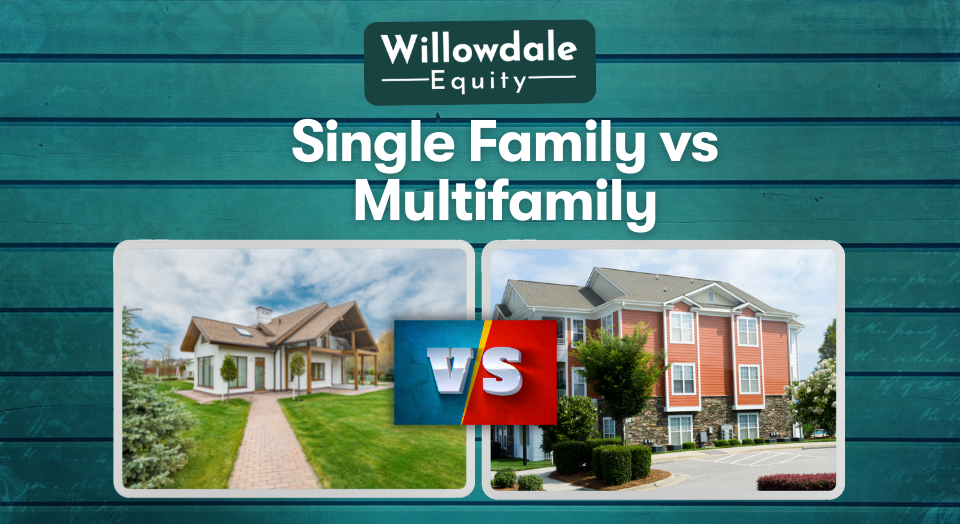
Single Family vs Multi Family Investing in 2024
This article is part of our passive investors guide on real estate syndications, available here.
There’s a lot of debate about whether to invest in multifamily or single-family real estate for the long term. Both have pros and cons and are an excellent means to wealth-building, but we believe one, in particular, is the long-term winner.
The natural evolution of most investors leads to commercial real estate; this is mainly because it gives investors the ability to purchase larger cash-flowing assets in each acquisition with less risk. If you are starting and looking to be an active real estate investor, single-family is an excellent way, as there are fewer barriers to entry.
In this article, we’ll discuss the advantages and disadvantages of both types of real estate.
Key Takeaways
-
Single-family homes are great for investors who want to actively manage their property. They are also great for beginners because there is less competition when buying, and they are easier to finance.
-
Multifamily rental properties are a much more difficult asset class to penetrate due to the complexity of the buyers you’re up against.
-
There are far more operational issues with managing 100 separate tenants in 100 houses scattered throughout a city. It’s much easier to operate from a property management standpoint if all 100 tenants reside on the same site in one multifamily apartment complex.
-
Multifamily properties are the most robust insulated asset class that provides all the best characteristics real estate investing offers.
Single-family vs Multi-Family
Single-family homes are great for investors who want to actively manage their property. They are also great for beginners because there is less competition when buying, and they are easier to finance. The main disadvantage of single-family homes is that they typically have lower returns than multifamily properties.
Multifamily rental properties are a much more difficult asset class to penetrate due to the complexity of the buyers you’re up against. Not to mention a more sophisticated capital structure, strict underwriting, and the many moving pieces needed to close and operate a building.
Let’s examine each one separately. While some owner-occupied multifamily properties, most are acquired to make money. As a result, their pricing is influenced more by the rental income they produce than by market conditions as a whole. As a result of these factors, the price stability of multifamily housing is higher. Multifamily houses tend to sell for lower multiples of their rental income than single-family homes.
Finally, multifamily houses naturally produce a variety of rental streams, which might be especially appealing to prospective investors. Consider it this way: if you acquire a triplex and one unit remains empty, you’ll still get two-thirds of your revenue. If your single-family home is vacant, you receive nothing.
Single-Family Real Estate Investing

- Fewer Barriers to entry
- Lower tenant turnover
- More liquid
Fewer Barriers to entry
Getting involved in single-family real estate requires significantly less capital to get started. Single-family properties generally require a much lower downpayment, deposit, and the transaction costs are much lower.
Lower tenant turnover rental property
Due to the nature of single-family property generally having one or two tenants, you should achieve lower turnover as you can focus more on finding and vetting the best tenant to lease your property out to. But a common recurring problem in single-family is if your tenant leaves, you’re 100% vacant and forced to cover the expenses out of pocket.
When we say it’s cheaper to start, we’re not only talking about the purchase price. It’s also about the down payment and other terms, as well as the financing itself, which are all more expensive for commercial real estate appraisals, and there’s greater liquidity when it comes to selling.
It takes time and money to replace a tenant. You (or your property manager) must coordinate cleaning, mending damages, and general wear and tear, and advertise and show the listing every time someone moves out. Not to mention the loss of revenue from renting out the space while it’s unavailable.
In a nutshell, single-family is a much larger and more liquid market as an asset class. So it’s a more straightforward product to sell since they are less expensive and there is a lower barrier to entry, with a much more extensive selection of potential customers. It’s not just real estate investors that buy and sell properties or real estate in general. But when it comes to single-family residences, you have a massive group of people who live where they buy.
More liquid rental properties
Single-family is generally more liquid in comparison to multifamily. The single-family real estate marketplace is much larger in terms of transaction volume and would be easier to firesale a property in the event that you needed to do so.
Multifamily Real Estate Investing

- Higher monthly cash flow
- Economies of scale
- Operational efficiency
- Better financing options
Higher monthly cash flow
Multifamily buildings are more complex to purchase and operate, so it can be challenging to find a buyer if you decide to sell. Multifamily cash flow is generally higher than single-family and more stabilized; for example, let’s say you have a 100-unit building and 15 units are vacant, which means you have an 85% occupancy. Many buildings can still be profitable or break even at worst, with vacancies as high as 20-30%!
Economies of scale

Furthermore, scaling is tricky because finding a good property management firm needs a higher percentage of your monthly revenue to manage the property, which strains your cash flow. When you compare this to multifamily, property management firms ask for a lower monthly percentage of the property’s overall income.
Multifamily property accompanies considerable cost savings, also known as economies of scale in economics. So when you have more units under one roof, you save money on common area renovations and mechanical upgrades like the boiler, hot water tank, and roofs. The economies of scale with multifamily units, especially as you go more significant in the unit count, get you to lower the management fee to operate the property. This could be somewhere between 3% to 6% whereas, in single-family, it could be as high as 10%.
Also, people are not being sent to various regions because all of your tenants would be on one site. Property management may be completely local, and onsite property managers are employed if the structure is big enough, typically above 100 units. Lastly, building a massive multifamily property portfolio is much easier and more profitable long term.
This is one of the main benefits of multifamily investing. As you reach economies of scale, your cost per unit lowers in terms of management and expenses. If you’re interested in building a long-term, lower-maintenance cash machine, multifamily real estate is the vehicle of choice, in our opinion!
Operational efficiency
There are far more operational issues with managing 100 separate tenants in 100 houses scattered throughout a city. It’s much easier to operate from a property management standpoint if all 100 tenants reside on the same site in one multifamily apartment complex.
The headache of traveling from house to house, collecting checks, and performing repairs are what add constraints to the way property management engages with the tenant base and operates the property. Multifamily buildings offer the potential for higher returns than single-family homes. This is because investors can charge more per unit and lower management costs.
Better financing options

Multifamily buildings are typically easier to finance than single-family homes. This is because lenders see multifamily as a safer investment and are more likely to give you a loan for a multifamily property.
Loans in the multifamily arena are sometimes easier to qualify for than a single-family home. This is because single-family is sometimes considered a higher risk for foreclosure as monthly cash flow can sometimes be harder to attain, weighing the qualifications heavier on the borrower’s income than the asset income.
It’s also worth noting that banks like the prospect of lending over $1,000,000 into a stabilized property. They find more stability in the upside of rental income the building generates on a month-to-month basis.
Some lenders have a more stringent approval process and higher multifamily loan rates. However, financing is complicated, and individual situations can vary considerably — especially when it comes to such a broad term as multifamily dwellings.
That said, obtaining a loan for a multi-million-dollar apartment complex might be more straightforward than getting one for a single-family property. But if you are co-investing with a syndicator, for example, the syndicator/sponsor of the deal would be the one qualifying for the financing, so this wouldn’t be a hurdle for investors participating in the deal.
Related Read: Analyzing A Multifamily Deal In Under 10 Minutes
Frequently Asked Questions About Multifamily Vs Single Family
There are many differences between the two asset classes; the main differences are in operational efficiencies, the liquidity of each asset type, the financing options available, and tenant turnover, to name a few.
We believe multifamily is one of the most robust investment vehicles, especially when compared to single-family. There are many reasons, but this is mainly due to the operational efficiencies and scaling ability that an apartment community provides to investors. Having one property that houses 100’s tenants provides significant efficiencies for property management and better pricing for operating expenses due to the scalability and convenience of local vendors to perform their work more effectively and at scale.
Yes, multifamily homes appreciate over time. That are many factors at play to determine at what rate. Still, the location and market of where the multifamily property will be the most significant indicator of what level of appreciation will take place. There are many factors why multifamily properties hold their value and continue to appreciate. One of the main reasons is that landlords generally can increase rents annually at the same inflation rate but, in many cases, at a much higher rate. This means multifamily properties are a substantial investment vehicle to provide cash flow today and preserve invested capital against natural inflation.
Single Family Vs Multi Family Investing - Conclusion
Many blogs for multifamily also like to compare the two asset classes and highlight the risks involved with either an apartment complex or a single-family home that is mainly related to the individual property. So make sure to do your due diligence when investigating a property to buy or rent to ensure you’re comfortable with the risks involved.
Multifamily properties are the most robust insulated asset class that provides all the best characteristics real estate investing offers. Although getting started with single-family may seem more attainable due to its lower barriers of entry, investing in multifamily doesn’t mean you have to operate it actively. At Willowdale Equity, we put the deal together, perform the construction, operate the property daily, execute the business plan, and allow real estate investors the opportunity to invest alongside us passively.
Interested In Learning More About PASSIVE Real Estate Investing In Multifamily Properties?
Get Access to the FREE 5 Day PASSIVE Real Estate Investing Crash Course.
In this video crash course, you’ll learn everything you need to know from A to Z
about passive investing in multifamily real estate.
We’ll cover topics like earned income vs passive income, the tax advantages, why multifamily, inflation, how syndications work, and much much more!




